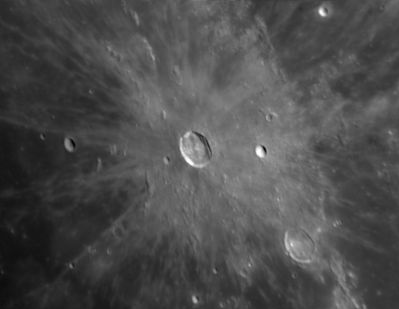Kepler
Contents
- 1 Kepler
- 2 Table of Contents
- 2.1 Images
- 2.2 Maps
- 2.3 Description
- 2.4 Description: Elger
- 2.5 Description: Wikipedia
- 2.6 Additional Information
- 2.7 Nomenclature
- 2.8 Van Langren's nomenclature
- 2.9 LROC Articles
- 2.10 LPOD Articles
- 2.11 Bibliography
- 2.12 The moon's Kepler area in the Sourcebook Project (William R. Corliss)
- 2.13 Johannes Kepler in the Sourcebook Project (William R. Corliss)
Kepler
|
Lat: 8.09°N, Long: 38.02°W, Diam: 29.49 km, Depth: 2.7 km, Rükl: 30, Copernican |
Table of Contents

Mike Wirths
Kepler at center of image, Kepler A to the east-southeast of it, Kepler C west-northwest of it, Encke south-southeast of it. Kepler F immediately west of Kepler.
Several hills and hillocks north of Kepler once received Greek letter designations. Of them, Kepler Omega is the nearest one.
Images
LPOD Photo Gallery Lunar Orbiter Images Apollo Images Wes Higgins
- AS12-52-7745 shows an oblique orbital view of Kepler (central), the bowl-shaped crater Kepler A (near the upper right corner), and a little bit of Encke in the lower right corner. Research: Danny Caes.
- A very impressive orbital photograph of Kepler and its surroundings, made by Lunar Orbiter 3 (Frame 3162), was included on pages 238-239 in the National Geographic of february 1969 (AWESOME VIEWS OF THE FORBIDDING MOONSCAPE; a nine-page portfolio). Research: Danny Caes.
- Wonderful models (moon dioramas) of crater Kepler and environs were created by Peter Romer of Hungary. Explore his page Crater Kepler and the surrounding area, and Gallery
Maps
(LAC zone 57B4) LAC map Geologic map
- IAU page Kepler
Description
Description: Elger
(IAU Directions) KEPLER.--One of the most brilliant objects in the second quadrant,--a ring-plain about 22 miles in diameter, with a lofty border; a peak on the W. attaining an altitude of 10,000 feet above the surface. The wall is much terraced, especially the outer slope on the E., where a narrow valley is easily traceable. Though omitted from the maps, there is a prominent circular depression on the E. border, which forms a distinct notch thereon at sunrise. On the N., the wall exhibits a conspicuous gap. There is a central hill on the floor. Immediately W. of Kepler is a bright plateau, bounded on the N. by a very straight border, with two small craters on its edge. Both these objects are incomplete on the N., as if they had been deformed by a "fault," which has apparently affected the N. end of Kepler also. Kepler is the centre of one of the most extended systems of bright streaks on the moon's visible surface.
Description: Wikipedia
Additional Information
- Depth data from Kurt Fisher database
- Pike, 1976: 2.7 km
- Arthur, 1974: 2.75 km
- Westfall, 2000: 2.7 km
- Viscardy, 1985: 2.75 km
- Cherrington, 1969: 2.28 km
- Central peak height
- Sekiguchi, 1972:
- Too small to measure "A low mound, probably the true central peak"
- 0.2 km "Another mound on the northerly eccentric position of the floor"
- 0.3 km "The largest mound on the north wall" - fatastronomer fatastronomer
- Sekiguchi, 1972:
- West rim slope 42° (Pohn, 1963)
- Included in ALPO list of bright ray craters
- Included on the ALPO list of banded craters
- Kepler and Kepler A are thermal anomaly craters, implying a youthful age - Moore et al, 1980
- TSI = 30, CPI = 20, FI = 20; MI =70 Smith and Sanchez, 1973
- The hills and hillocks west of Kepler are parts of the rim of an unnamed 55 kilometer wide impact crater, see LPOD Streamlined Islands 6-4-13
- Suspected remains of a larger-than-Kepler crater west of Kepler itself, northeast of Kepler D. Two small sections of the rim of this suspected crater are still detectable, they were once called Kepler Kappa and Kepler Pi. See chart SLC F4 (System of Lunar Craters, 1966).
Nomenclature
- Named for Johannes Kepler (December 27, 1571 - November 15, 1630), a German Lutheran mathematician, astronomer and astrologer, and a key figure in the 17th century astronomical revolution. He is best known for his eponymous laws of planetary motion, codified by later astronomers based on his works. As a student Kepler wrote a dissertation on the nature of the Moon, and his later book on optics contains ideas and observations of the Moon from the period immediately before the "discovery" of the telescope. Kepler is also credited with writing one of the first science fiction novels -- an imaginary trip to the Moon.
- This name was introduced in the form Keplerus by Riccioli. It was modifed to Kepler by Beer and Mädler, and all subsequent authors appear to have followed their lead (Whitaker, pp. 213 and 123).
- This name was part of the original IAU nomenclature of Blagg and Müller(1935).
Van Langren's nomenclature
(source: E.A.Whitaker's Mapping and Naming the Moon)
- Kepler (Van Langren's Thomae D.Sab.).
- Kepler Gamma (Van Langren's Laucii).
- Kepler Theta (Van Langren's Garsioli).
LROC Articles
LPOD Articles
- A Smarter Kepler
- Kepler Ahead
- Splayed Rays
- Rayless Crater
- Kepler
- Delta-Rim Craters
- Happy Birthday Johannes
Bibliography
Kepler Crater as Seen by SMART-1
The moon's Kepler area in the Sourcebook Project (William R. Corliss)
- In: Mysterious Universe, a handbook of astronomical anomalies (1979) :
- Page 237: Excitation of Lunar Luminescence by Solar Activity (Zdenek Kopal and Thomas W. Rackham, Icarus, 1963).
Johannes Kepler in the Sourcebook Project (William R. Corliss)
- In: Mysterious Universe, a handbook of astronomical anomalies (1979) :
- Page 180: Abnormal Obscurity of the Moon in the Late Eclipse (S.J.Johnson, Monthly Notices of the Royal Astronomical society, 1884).
- Page 182: Why was last December's Lunar Eclipse so Dark? (December 30, 1963) (Edward M. Brooks, Sky and Telescope, 1963).
Named Featues -- Prev: Kepínski -- Next: Khvol'son
This page has been edited 1 times. The last modification was made by - tychocrater tychocrater on Jun 13, 2009 3:24 pm - afx3u3
